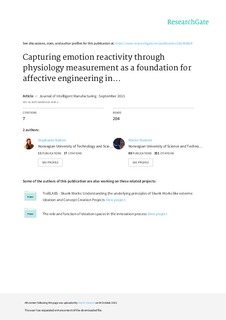| dc.contributor.author | Balters, Stephanie | |
| dc.contributor.author | Steinert, Martin | |
| dc.date.accessioned | 2017-08-03T12:21:40Z | |
| dc.date.available | 2017-08-03T12:21:40Z | |
| dc.date.created | 2015-10-19T09:12:29Z | |
| dc.date.issued | 2017 | |
| dc.identifier.citation | Journal of Intelligent Manufacturing. 2017, . | nb_NO |
| dc.identifier.issn | 0956-5515 | |
| dc.identifier.uri | http://hdl.handle.net/11250/2449839 | |
| dc.description.abstract | This paper presents the theoretical and practical fundamentals of using physiology sensors to capture human emotion reactivity in a products or systems engineering context. We aim to underline the complexity of regulating (internal and external) effects on the human body and highly individual physiological (emotion) responses and provide a starting point for engineering researchers entering the field. Although great advances have been made in scenarios involving human-machine interactions, the critical elements—the actions and responses of the human—remain far beyond automatic control, because of the irrational behavior of human subjects. These (re)actions, which cannot be satisfactorily modeled, stem mostly from the fact that human behavior is regulated by emotions. The physiological measurement of the latter can thus be a potential door to future advances for the community. In this paper, following a brief overview of the foundations and ongoing discussions in psychology and neuroscience, various emotion-related physiological responses are explained on the basis of a systematic review of the autonomic nervous system and its regulation of the human body. Based on sympathetic and parasympathetic nervous system responses, various sensor measurements that are relevant in an engineering context, such as electrocardiography, electroencephalography, electromyography, pulse oximetry, blood pressure measurements, respiratory transducer, body temperature measurements, galvanic skin response measurements, and others, are explained. After providing an overview of ongoing engineering and human-computer interaction projects, we discuss engineering-specific challenges and experiment setups in terms of their usability and appropriateness for data analysis. We identify current limitations associated with the use of physiology sensors and discuss developments in this area, such as software-based facial affect coding and near-infrared spectroscopy. The key to truly understanding user experience and designing systems and products that integrate emotional states dynamically lies in understanding and measuring physiology. This paper serves as a call for the advancement of affective engineering research. | nb_NO |
| dc.language.iso | eng | nb_NO |
| dc.publisher | Springer Verlag | nb_NO |
| dc.rights | Navngivelse 4.0 Internasjonal | * |
| dc.rights.uri | http://creativecommons.org/licenses/by/4.0/deed.no | * |
| dc.title | Capturing emotion reactivity through physiology measurement as a foundation for affective engineering in engineering design science and engineering practices | nb_NO |
| dc.type | Journal article | nb_NO |
| dc.type | Peer reviewed | nb_NO |
| dc.description.version | publishedVersion | nb_NO |
| dc.source.pagenumber | 23 | nb_NO |
| dc.source.journal | Journal of Intelligent Manufacturing | nb_NO |
| dc.identifier.doi | 10.1007/s10845-015-1145-2 | |
| dc.identifier.cristin | 1281403 | |
| dc.relation.project | Norges forskningsråd: 236739 | nb_NO |
| dc.relation.project | Norges forskningsråd: 236739/O30 | nb_NO |
| dc.description.localcode | © The Author(s) 2015. This article is published with open access at Springerlink.com. This article is distributed under the terms of the Creative Commons Attribution 4.0 International License (http://creativecommons.org/licenses/by/4.0/), which permits unrestricted use, distribution,and reproduction in any medium, provided you give appropriate credit to the original author(s) and the source, provide a link to the Creative Commons license, and indicate if changes were made. | nb_NO |
| cristin.unitcode | 194,64,50,0 | |
| cristin.unitname | Institutt for produktutvikling og materialer | |
| cristin.ispublished | true | |
| cristin.fulltext | original | |
| cristin.qualitycode | 2 | |

